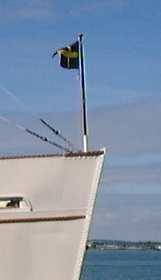 |
After anchoring overnight at Yarmouth, Saturday morning saw the Waverley at Southampton. Captain Steve Colledge was in command, but his Welsh origin was denoted by St David's flag on the jack staff, rather than the familiar dragon. |
<!--#easybanner-->
Return to the South Coast
The mighty paddler left Glasgow as soon as possible after completion of her scheduled Clyde sailings, at midnight on Tuesday morning, to take advantage of prevailing good weather. This paid off as the entire passage to Weymouth was made in a flat calm throughout.
The first sailing was given on Friday 31 August from Weymouth, with her stores due at 9 a.m. being delivered to Glasgow and not finally catching up with the ship at 11 p.m. at Bournemouth! An evening cruise was given from Bournemouth to view the annual fireworks. Our correspondent described the display as "OK - they didn't last very long!"
 |
After anchoring overnight at Yarmouth, Saturday morning saw the Waverley at Southampton. Captain Steve Colledge was in command, but his Welsh origin was denoted by St David's flag on the jack staff, rather than the familiar dragon. |
Waverley was berthed adjacent to S.S. Shieldhall, which was also due to sail at 11.00 for a Solent cruise. |
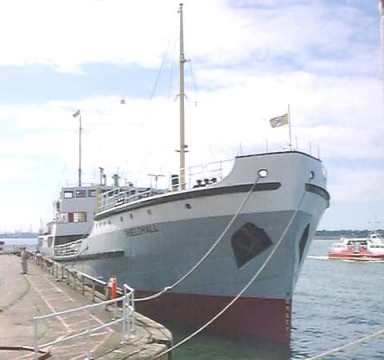 |
|
Under blue skies, the paddler set sail flying the Cosen's house flag from the starboard mainmast halliard, and a Nynas (the company bunkering the Waverley) flag on the port side. The Cosens flag was part of the Celebration Weekend marking the publication of "Cosens of Weymouth - 1918 to 1996" by Richard Clammer, now available from Waverley's souvenir shop. Andrew Gladwell prepared a special leaflet. |
Good time was made to Portsmouth but harbour traffic delayed arrival at the Station Pier. The new Wightlink car ferry St Clare preceded the paddler into port, ... |
|
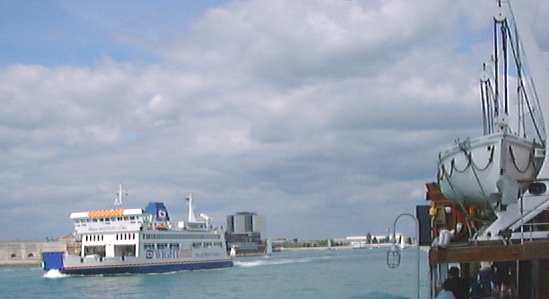 |
...while the first 'Saint' St Catherine departed for Fishbourne. While our steamer was alongside the Normandie and Pride of Le Havre entered harbour from Caen and Le Havre respectively. The Blue Launch Peter James assisted the paddler turn in the harbour. |
And so to Sandown where Captain Colledge took the eastern berth. After a lengthy exchange of passengers, the steamer turned to the west to commence her circumnavigation of the Isle of Wight. This was accomplished in just about four hours at an average speed of 13.5 knots. On the return to the eastern berth, the tide carried the stern way from the pier and a second approach had to be made, this time to the southern berth.
On passage to Portsmouth the P&O liner Aurora passed by for Boston, Mass. |
|
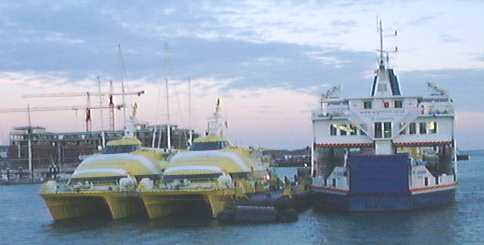 |
Leaving the Station Pier simultaneously with the Waverley, were Wightlink's 1981 catamaran Our Lady Pamela, for Ryde, and Portsmouth Harbour Ferries' Solent Enterprise, for an evening disco cruise. Alongside the 'Odds and Evens' mooring were the two 1996 catarmarans Fastcat Shanklin and Fastcat Ryde, both out of use today, the car ferry St Catherine and (out of sight) the other 1981 catamaran Our Lady Patricia. |
In HM Dockyard were the destroyer HMS Chatham and the aircraft carrier HMS Ark Royal, just back from her £357 million refit at Rosyth. A quick run was made to Southampton with a sustained period at 52 r.p.m. |
 |
|
Sunday started grey and a little rain was encountered between Southampton and Yarmouth, but the weather remained dry thereafter. Captain Gellatly had resumed command and the saltire had consequently returned to the jack staff. The inner channel was taken for the next stage to Bournemouth, where the western berth was taken. Then across the bay to Swanage, with a pause to allow a dinghy race, with about 50 competitors, to cross our bow. A new mast has been erected on the upper deck of Swanage Pier, seen here flying a Waverley name pennant to show approaching mariners the wind speed and direction. Finally along the Purbeck coast to Weymouth for time ashore. |
|
|
|
| While alongside, the opportunity was taken to launch the port lifeboat to attend to some damage to the belting, and the recovery process is shown above. | ||
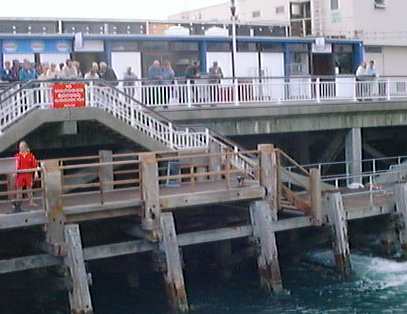 |
On the return passage we were treated to an expert commentary by Richard Clammer. Berthing at Bournemouth was tricky with a strong tidal current joining with a brisk wind from the west to push the paddler rapidly off the eastern berth. A second run in was required to take the pier, with its recently raised landing stage. Similarly at Yarmouth. All paddle steamers are at the mercy of wide and tide once steerage way is lost, while most modern ferries rely on bow thrusters or Voith-Schneider propulsion to hold their position until made fast. Thus any slip up in rope handling can result in the need for a second approach. The final run to Southampton was again made in cracking style, final arrival being just 25 minutes late. |
Martin Longhurst